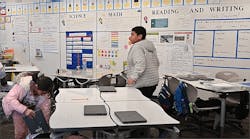In today's economic climate, Americans must find creative ways to do more with less. School and university administrators are challenged with stretching budgets to compensate for the increased costs of construction, maintenance and operations. Funding is likely to remain a struggle as it becomes increasingly difficult to convince taxpayers in some regions to pass needed bonds, and tax revenue growth slows.
Furniture is a tempting place to save money. It is one of the last things put in place in a construction project, and when money gets tight, it may seem like an easy solution is to skimp on quality in favor of what is affordable. This scenario is bad news for the middle school student who is taller than normal for his age and must cram his legs to fit under a desk that is too low for his build, or for the college student that must sit in an uncomfortable seat with metal legs for a 90-minute biology lecture.
To create a proper learning environment, furniture should be durable, flexible, aesthetic, maintainable, comfortable and affordable. And thanks to many education furniture manufacturers, the goal of purchasing furniture with these characteristics is becoming more attainable.
A changing price point
Once upon a time, furniture purchasing may have been as simple as flipping through a catalog, finding something that matched the needs of a given space, and paying what was on the price tag. That process has changed, however, and school and university administrators now have more bargaining power.
“What's really changing is the price point, and the manufacturers have really realized the market that [education institutions] provide,” says Debbi Moody, senior associate and interior designer with Yost Grube Hall Architecture in Portland, Ore.
Updating yesterday's designs from the 1960s and '70s to be more ergonomic and accessible has made education furniture a large market, says Moody.
“There's been a lot of energy put into producing a good, quality product at a good price point that makes it affordable,” she says.
The declining cost of innovative furniture systems is opening doors that previously had been locked for many education institutions. More schools and universities are finding it feasible to consider more than just stationary furniture in a one-size-fits-all solution.
Instead, they are seeing the advantages of selecting furniture that is adjustable for the individual student. Their shopping criteria might include seats that are large enough for a variety of sizes and in materials such as mesh that may be more comfortable for students, while also being easier to maintain.
A changing price point has made it possible for schools and universities to use height-adjustable chairs on a larger scale, says Moody.
In computer labs, this type of chair can be adjusted to enable students to use keyboards in a more ergonomic fashion.
With the amount of time students spend in their learning environments, it is worth an education institution's time and effort to select the best furniture solution possible. If the price tag boasts a cost that is too high, other options do exist — as long as those in charge of purchasing don't mind a little bargain shopping.
Deal or no deal?
In the past, quality furniture came at a cost, and those that opted to save money upfront often got what they paid for in the end. Although there still is a price to quality, it is not as clear-cut as it may have been at one time. Education institutions looking to purchase furniture have buying power, as more manufacturers make their way into the market and compete for the same business.
When looking for the best price, purchasers should research all of their options. Many companies that traditionally have produced furniture for the workplace now are developing furniture systems for education, says Steve McCollom, associate partner with Gary Lee Partners, an architecture and design firm with offices in Chicago, New York and San Francisco.
These untraditional suppliers might have a more affordable alternative to traditional education furniture suppliers. This means schools and universities could gain quality furniture through an untraditional source at a more affordable price, or use that price to bargain for a similar deal with a more traditional supplier.
Another advantage to shopping around is finding variety. Some companies that haven't traditionally produced furniture for education may be able to offer more of a design edge.
Universities, particularly, are seeking sophisticated designs that are more “sexy,” says McCollom. Higher-education institutions are in heated competition with one another, and as a result, more colleges and universities are placing a greater value on the power of a first impression. By shopping around and seeing what different furniture manufacturers have to offer, purchasers may be able to find unique, personal solutions at reasonable prices.
The big bang
More manufacturers supplying more options means more bargaining power — but not just concerning costs. Some manufacturers offer value-added services along with furniture purchases that include space planning and floor layout. This could help schools that aren't working directly with an architect.
“You've got to shop and competitively shop, compare pricing and really look for what we call ‘best value,’ which is not necessarily the lowest bid, the lowest price, but a combination of things — quality, delivery, service, follow up — all of those things add to the best value equation,” says John R. Miller, CPPO, director of purchasing at Harford County Public Schools, Bel Air, Md.
Many manufacturers are willing to work with schools and universities that will be making large purchases. Education institutions should express their needs to manufacturers and see if they can get a discount for large purchases, says Moody.
“What they need to do is start talking to the manufacturers and suppliers, ‘Say over the next 18 months, this is what we anticipate in the volume of furnishings we're going to buy; therefore, we'd like you to price it based on this volume of furniture,’ because the more volume you give them, the better the cost is.”
Smart spending
Aside from wheeling and dealing, education institutions can explore different funding avenues that may allow them to make purchases at a more affordable price. Many schools and universities use third-party purchasing agents and cooperatives, which establish contracts with participating manufacturers and then allow schools and universities to buy through them at special rates.
Harford County Public School's purchasing department uses cooperatives whenever they are determined to be in the schools' best interest, says Miller.
“… If we feel we need to go out to competitive bid, then we'll do that as well,” he says. “It's circumstantial really.”
Local and state governments also can partner with furniture manufacturers to come up with purchase agreements, and then open up their contracts to education institutions.
Schools and universities can research these options through their state's Department of Administrative Services or the department responsible for purchasing in their state.
Sidebar: Saving green
Cost efficiency and sustainability sometimes go hand-in-hand. Education institutions should keep an eye out for opportunities to purchase used furniture or refurbish old furniture instead of buying new. This can help budgets stretch, as well as help schools and universities earn points toward LEED certification.
Portland Community College, Portland, Ore., took advantage of such an opportunity when it was looking for furnishings for instruction and office space in a seven-building remodel and new construction on one of its campuses. The construction budget only allowed for new furniture purchases for the new construction, leaving little to work with for the remodeled spaces.
A local company that had just gone out of business offered used systems furniture that was a few years old to the college. By purchasing the used product, Portland Community College was able to replace all of the office furnishings on the entire campus — including the new construction and the remodel. By doing this, the college even was able to reupholster some of the furniture panels and still stay well under budget.
By keeping their minds open to creative ways to save, school and university administrators can learn of these types of opportunities and capitalize on them. They can seek out furniture dealerships that might be able to offer used furniture. Through a Web search or word-of-mouth, they might be able to happen upon some deals that fit their needs. They even may be able to seek out organizations that are willing to donate furniture to improve the learning environments of local schools or universities.
Hall is former associate editor.


